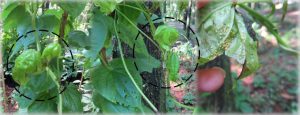By Dr. Christopher Kerr1 and Dr. Carey Minteer2
1: Division of Plant Industry, Florida Department of Agriculture and Consumer Services, Gainesville FL
2: University of Florida, Institute of Food and Agricultural Sciences, Indian Rover Research and Education Center, Fort Pierce, FL
A biological control program utilizing air potato leaf beetles to control the air potato vine has concluded. These beetles are no longer available upon request. Air potato leaf beetles have been shown to successfully overwinter, and they emerge the following year continuing their control of this noxious weed. However, the concerns we most often hear are that “No beetles are showing up and the vine is growing like crazy”. On select sites, this may be true; but it is highly unlikely to occur across a region. Through our observations we have found that occasionally beetles will not return to a given site until late in the season, particularly on sites where they occurred early during the previous season and severely defoliated the air potato vines. The reasoning for this is simple, the beetles need the vine’s foliage to survive, once they have fed extensively on a site the adult beetles will migrate to a new area. If they are present towards the end of the season, or roughly late September, then there is a good chance they will be overwintering on that site.
Based on experience we have found that the beetles will not emerge from overwintering until roughly 4 weeks after the plant has begun to sprout; this therefore likely pushed natural air potato beetle emergence back to the beginning week(s) of June. When we couple this fact with the greater than normal rainfall during May we now have a situation where there are low populations of beetles later in the season which must be identified in an air potato vine infestation that has grown more rapidly. Needless to say, it can be hard to see small populations. The good news is with a normal generation time of about 1 month, we should expect larger, more apparent populations by mid-July. If beetles are still not seen at this time, then you may consider requesting additional beetles for release.

Identifying an infestation is best accomplished by searching for signs of air potato beetle damage, instead of searching for the beetles. Once populations are large enough the beetles will be more readily noticed. Feeding damage may appear as small holes in the foliage, paper-thin leaves, or completely skeletonized leaves where only leaf veins remain (Figure 1). However, when the populations are particularly low, the best sure-fire way to identify potential air potato beetle presence is by looking at the youngest leaves. If egg-laying females are present you will start to see that the youngest leaves will be cupping downward. This occurs because females nip at the epidermal layers of the leaves to cause this downward curling, in order to create an ideal, protected environment to lay their eggs. Figure 2 shows some cupped leaves, and what we found inside. Don’t be surprised if you don’t see any eggs in those cupped leaves though, they’ll start creating these “egg-laying” sites even before they start laying eggs.

 0
0
